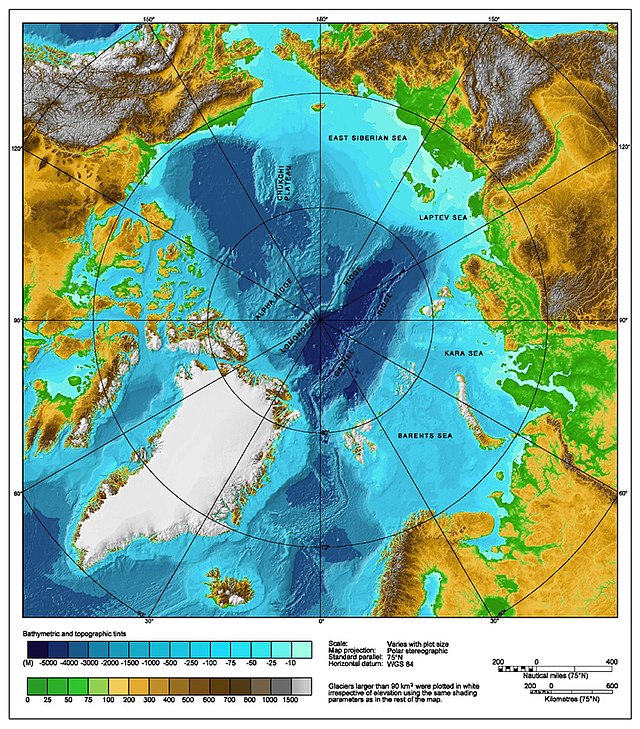Arctic Ocean
smallest, shallowest, coldest, and northernmost of the world's major oceans From Wikipedia, the free encyclopedia
Remove ads
The Arctic Ocean is the ocean around the North Pole. The most northern parts of Eurasia and North America are around the Arctic Ocean. Thick pack ice and snow cover almost all of the ocean in winter and most of it in summer. An icebreaker and a nuclear-powered submarine can use the Northwest Passage through the Arctic Ocean to go between the Pacific and Atlantic Oceans.

The Arctic Ocean has an area ocean of 14.056 million km2, the smallest of the world's five oceans, and it has a coastline of 45,389 kilometres (28,203 miles). The central surface is covered by ice about 3 metres (9.8 feet) thick.
Its biology is quite special. Endangered species include walruses, whales, and polar bears. Year by year, the Arctic Ocean is becoming less icy as a result of global warming.
The average depth of the Arctic Ocean is 1,038 metres (3,406 feet).[1] Its deepest point is in the Eurasian Basin, at 5,450 m (17,881 ft).
Remove ads
Geography
The Arctic Ocean covers an area of about 14,056,000 km2. The coastline is 45,390 km (28,200 mi) long[2] It is surrounded by Eurasia, North America, and Greenland and several other islands.
The ocean is generally taken to include Baffin Bay, Barents Sea, Beaufort Sea, Chukchi Sea, East Siberian Sea, Greenland Sea, Hudson Bay, Hudson Strait, Kara Sea, Laptev Sea, White Sea, and other bodies of water. It is connected to the Pacific Ocean by the Bering Strait and to the Atlantic Ocean by the Greenland Sea and the Labrador Sea.
Countries bordering the Arctic Ocean are Russia, Norway, Iceland, Greenland (part of Denmark), Canada, and the United States.
Remove ads
Climate
The Arctic Ocean has a polar climate. Its winter is characterized by the polar night, cold and stable weather conditions, and clear skies.
The temperature of the surface of the ocean is fairly constant, near the freezing point of seawater. The ocean consists of saltwater but has less salinity than other oceans have. The ocean's temperature must reach −1.8 °C (28.8 °F) before freezing occurs.
Ice covers almost all of the Arctic Ocean in late winter and the majority of it in late summer. Much of the Arctic ice pack is covered in snow for about 10 months of the year. The maximum snow cover is in March or April, at about 20–50 cm (7.9–19.7 in.).
The climate of the Arctic region has varied significantly in the past. As recently as 55 million years ago, during the Eocene epoch, the region reached an average annual temperature of 10–20 °C (50–68 °F). The surface waters of the Arctic Ocean warmed enough to support tropical lifeforms.
Remove ads
Animal and plant life
Endangered marine species in the Arctic Ocean include walruses and whales. The area has a fragile ecosystem. The Arctic Ocean has relatively little plant life except for phytoplankton. A crucial part of the ocean, phytoplankton feeds on nutrients from the rivers and currents of the Atlantic and the Pacific Oceans.
References
Other websites
Wikiwand - on
Seamless Wikipedia browsing. On steroids.
Remove ads

